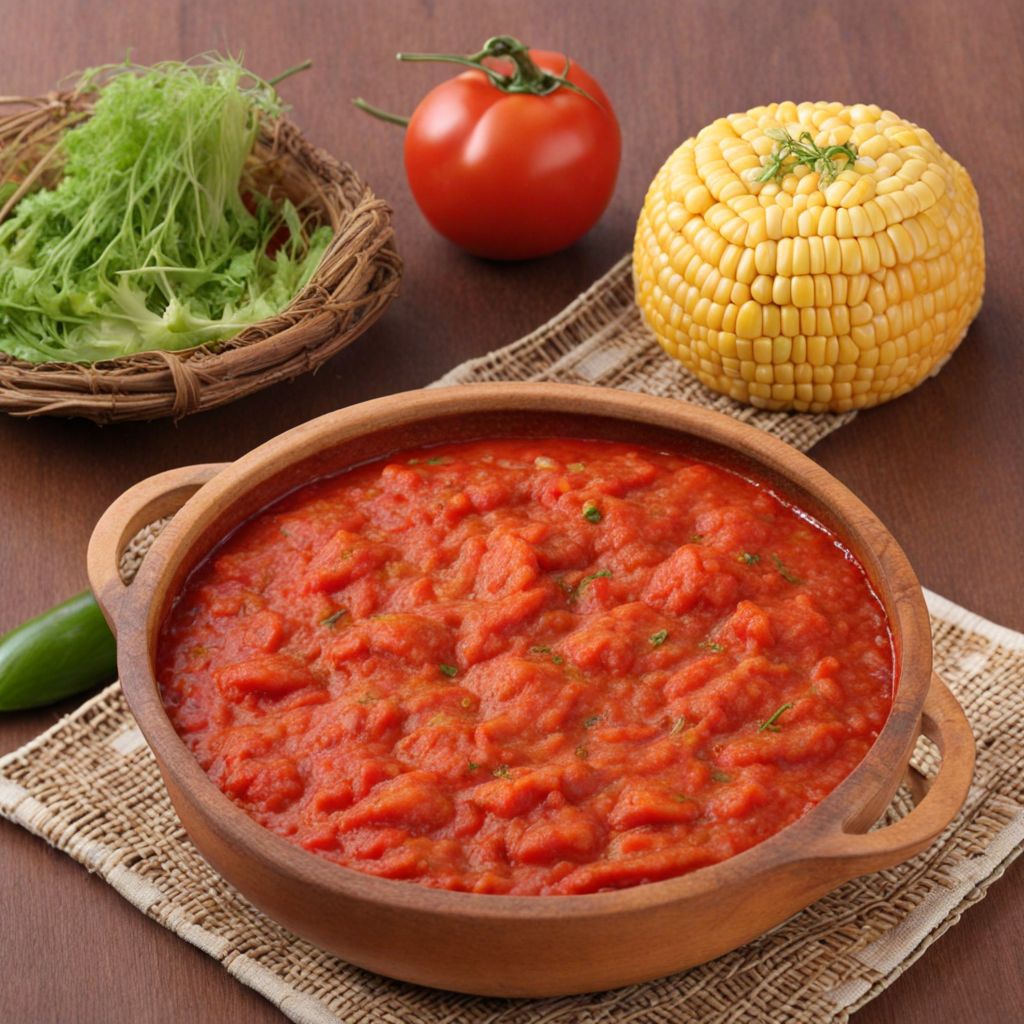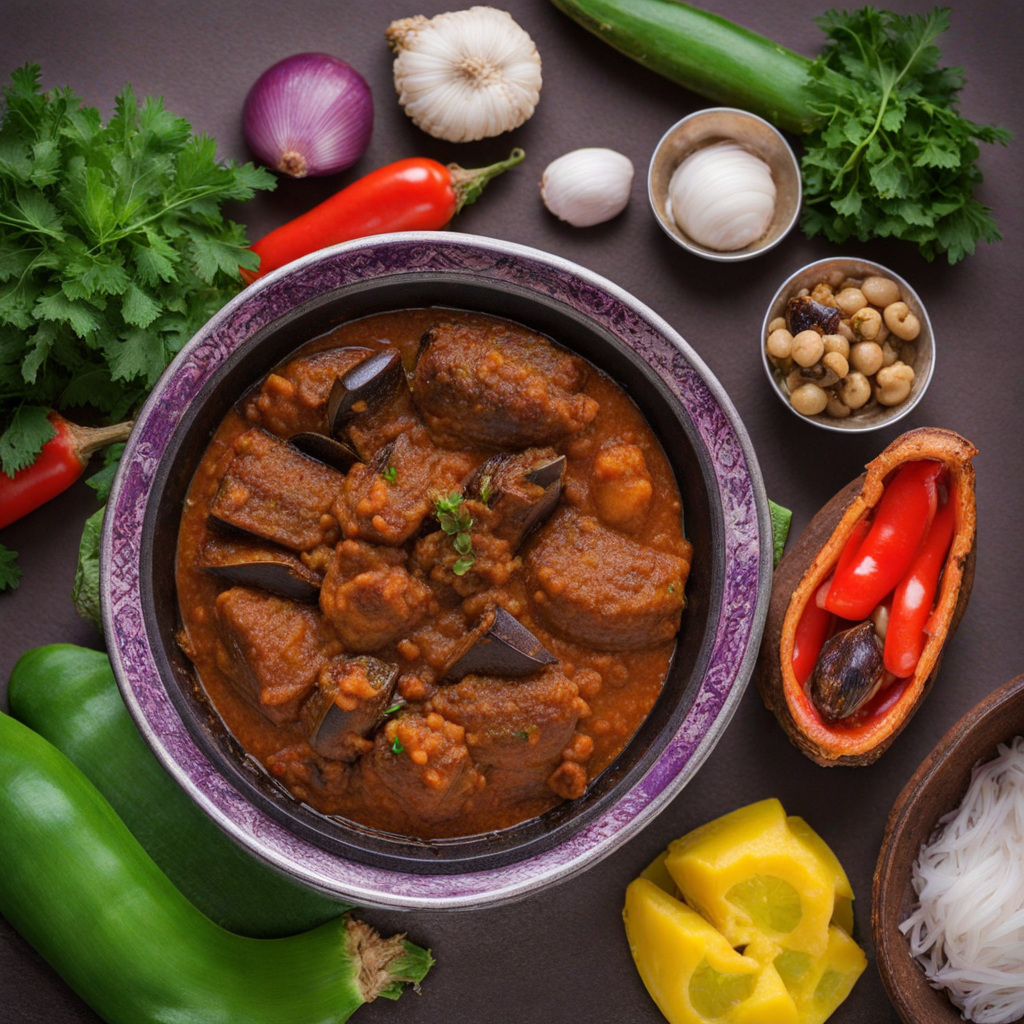Amiwo
Amiwo is a delightful dish from Benin, renowned for its vibrant colors and rich flavors that reflect the country's diverse culinary heritage. At its core, Amiwo is a cornmeal-based dish, often enriched with spices and flavorings that create a unique taste experience. The dish is typically prepared with finely ground cornmeal, which is cooked to a smooth and slightly thick consistency. This base is then infused with a variety of ingredients, such as palm oil, which gives it a distinctive reddish hue, and spices like pepper, onion, and sometimes garlic, creating a fragrant, savory aroma that is simply irresistible. The texture of Amiwo is soft and pliable, making it perfect for pairing with a range of accompaniments. It is often served with a selection of stews or sauces, which can vary from mild to spicy, depending on the region and personal preference. Common pairings include vegetable stews, fish, or meat dishes, which enhance the overall flavor profile of the meal. The combination of Amiwo with these flavorful sauces not only elevates the taste but also offers a satisfying contrast between the creamy cornmeal and the robust, hearty toppings. Amiwo is more than just a dish; it is a celebration of Benin's culinary traditions and the communal spirit of sharing food. It is often enjoyed during family gatherings or special occasions, where friends and loved ones come together to savor its deliciousness. The experience of enjoying Amiwo is as much about the food itself as it is about the connection to culture and community, making it a truly memorable taste of Benin that invites anyone to explore its rich gastronomic landscape.
How It Became This Dish
The History of Amiwo: A Culinary Treasure from Benin Introduction Amiwo, a traditional dish from Benin, is not just a meal; it is a symbol of heritage, community, and resilience. Known for its vibrant color and rich flavors, amiwo is a beloved staple that showcases the culinary ingenuity of the Beninese people. This dish, made primarily from cornmeal, is often served with a variety of delicious accompaniments, including stews, vegetables, and meats. To understand amiwo is to delve into the rich tapestry of Benin's history, culture, and the evolution of its gastronomy. Origins of Amiwo The roots of amiwo can be traced back to the indigenous agricultural practices of the Fon people, one of the largest ethnic groups in Benin. Corn, or maize, was introduced to West Africa from the Americas in the late 15th century, and it quickly became a staple crop. The adaptability of corn to various soil types and climates made it an essential part of the agricultural landscape. As communities began to cultivate maize, they experimented with different preparation methods, leading to the creation of amiwo. Amiwo derives its name from the Fon language, where "ami" means "to eat" and "wo" means "red," referencing the dish's characteristic reddish hue. This color is typically achieved through the addition of palm oil, which not only enhances the visual appeal of the dish but also infuses it with flavor and nutritional benefits. The use of palm oil in amiwo is significant, as it reflects the culinary practices of the region and the importance of palm trees in West African culture. Cultural Significance Amiwo is more than just food; it is a cultural artifact that embodies the values and traditions of the Beninese people. The dish is commonly served during various ceremonies and celebrations, such as weddings, naming ceremonies, and festivals. Its preparation often involves the participation of family and community members, reinforcing social bonds and collective identity. In Benin, the act of sharing a meal is a profound expression of hospitality and generosity. Amiwo is typically served in large quantities, allowing families and guests to gather around the table to enjoy the dish together. This communal aspect of dining is deeply ingrained in Beninese culture, where food acts as a bridge between generations, fostering a sense of belonging and continuity. Development Over Time Over the years, amiwo has evolved, adapting to the changes in society, economy, and culinary trends. Traditionally, the dish was prepared using simple techniques passed down through generations. Women, who were often the primary cooks in households, used locally sourced ingredients to create amiwo. Cornmeal was cooked with water and palm oil, and the mixture was stirred until it reached a thick, porridge-like consistency. It was then shaped into balls or served as a mound on a plate. As urbanization and globalization took hold in Benin, the preparation and consumption of amiwo began to change. With the influx of new cooking technologies and ingredients, variations of the dish emerged. For instance, some cooks began to incorporate spices and herbs from other cultures, enhancing the flavor profiles of amiwo. Additionally, the rise of convenience foods and fast-casual dining options has influenced how amiwo is served and consumed, especially in urban areas. Despite these changes, traditional preparations of amiwo remain popular, especially in rural areas where cultural practices are still strongly upheld. Many families continue to prioritize the use of local ingredients, celebrating the dish's authenticity and connection to their heritage. In recent years, there has also been a resurgence of interest in traditional cooking methods, as young chefs and home cooks seek to preserve and promote their culinary heritage. Modern Interpretations In contemporary culinary scenes, amiwo is experiencing a renaissance. Chefs in Benin and beyond are reimagining this classic dish, infusing it with innovative techniques and global flavors. Some have begun to pair amiwo with international cuisines, creating fusion dishes that appeal to a wider audience. For example, amiwo might be served alongside grilled meats or seafood, reflecting the growing influence of global gastronomy. Moreover, there is a growing movement focused on sustainable and ethical food practices in Benin. Many chefs and home cooks are emphasizing the importance of using organic, locally sourced ingredients, thus ensuring that amiwo remains a dish that not only nourishes the body but also supports local farmers and the economy. Amiwo in the Global Context As Benin continues to gain recognition on the world stage, amiwo has begun to attract attention beyond its borders. Food festivals, cultural exchanges, and culinary tourism initiatives are introducing this traditional dish to a broader audience. Through these platforms, amiwo is not only celebrated for its taste but also for its story—a story that encapsulates the history, resilience, and creativity of the Beninese people. The rise of social media has also played a crucial role in the global appreciation of amiwo. Food bloggers and influencers are showcasing the dish, sharing recipes, and highlighting its cultural significance. This digital exposure has sparked curiosity and interest, inviting people from diverse backgrounds to explore the flavors and narratives of Benin. Conclusion Amiwo is a culinary gem that embodies the rich cultural heritage of Benin. From its origins rooted in indigenous agricultural practices to its modern interpretations, amiwo serves as a testament to the resilience and adaptability of the Beninese people. It is a dish that unites generations, nurtures community bonds, and invites exploration and appreciation from all corners of the globe. As it continues to evolve and thrive, amiwo remains a delicious reminder of the power of food to connect us to our past and to one another.
You may like
Discover local flavors from Benin







